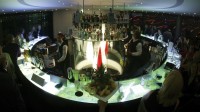Red Bull Hangar-7 – Multimedia Staging
The Red Bull Hangar-7 at Salzburg Airport
fulfils many purposes, which at first glance seem to conflict with one another. It is an air show centre with an air base
for aerobatic troops and an aircraft showroom with numerous restored classic, veteran planes. It is also a location for art
and lifestyle events and top-class gastronomy. The multimedia installations produced by checkpointmedia for this "high-tech
entertainment area", reflect the building’s multiple uses.
The entertainment factor is of prime importance and aims to
give visitors a great experience, full of surprises and excitement, in line with the company's image. After dark, visitors
are shown the way to the hangar by means of a huge projection of the Red Bull logo.
Next to the entrance is the Doppler
Foyer, which transforms a scientific topic into a sensory experience: centrally controlled light devices conjure up an artistic
visualisation of the Doppler Effect (named after the Salzburg physicist Christian Doppler); transparent DVD-steles serve as
information carriers and add audio elements to a sound collage.
The opening of Hangar-7 on August 22nd,
2003 stayed with the topic of flying and featured its own 1960s-style stewardess costumes for the hostesses. Steles shaped
like aircraft tail assemblies displayed videos, pictures and information about the exhibited aircraft. Invitations were designed
like VIP tickets and sent with a specially made folder and box. A Hangar-7 umbrella was designed and produced in the oval
shape of the hangar. The main attraction in Hangar-7 is the Mayday Bar, which was equipped with interactive features between
2003 and 2010. The almost circular surface (270°) was conceived and developed as a continuous screen for interaction with
the worlds of animation played out on it: aircraft of the Flying Bulls hovered over the Salzburg landscape, wrapped themselves
round glasses, or fled from ashtrays. In a second setting - New York, comic style - amusing waiters interacted with cocktail
glasses and mobile phones. Visitors to the bar could communicate with each other via a virtual communicator, a contemporary
version of the legendary table telephone. In 2003, the technical implementation of the Mayday Bar was a complex matter: 38
PCs in 18 modules, each with a projector, detected what was happening at the bar through infrared sensors. The computer registered
the data objects, which in turn triggered a programmed interactive response. The technology was integrated into the bar
counter and completely invisible to guests.
There are mini-multimedia gimmicks in Hangar-7 as well, like the WC
chat: guests can create cartoons and speech bubbles – virtual graffiti – with which to communicate between the ladies' and
gents' toilets. In the hangar’s interior, tailored audio-visual equipment was conceived and developed both for the main area
as well as for the gastronomy zones and private VIP rooms.
Client: Red Bull Hangar-7 GmbH
& Co KG
Architect: Volkmar Burgstaller
Technical director: Stefan Unger
Artistic direction: Virgil Widrich
Commercial management: Stefan Reiter
Programming: Christian Drucker
Interaction design: Martin Osen
Graphic
design: Instant design
 Hangar-7, Salzburg
Hangar-7, Salzburg  "Mayday Bar" at Hangar-7, photo: Helge Kirchberger/Red Bull Hangar-7
"Mayday Bar" at Hangar-7, photo: Helge Kirchberger/Red Bull Hangar-7  "Mayday Bar" at Hangar-7, detail
"Mayday Bar" at Hangar-7, detail  "Mayday Bar" at Hangar-7, illustration: Martin Osen
"Mayday Bar" at Hangar-7, illustration: Martin Osen  "Mayday Bar" at Hangar-7, illustration: Martin Osen
"Mayday Bar" at Hangar-7, illustration: Martin Osen  "Doppler Foyer" at Hangar-7, photo: Andreas Hauch
"Doppler Foyer" at Hangar-7, photo: Andreas Hauch 
